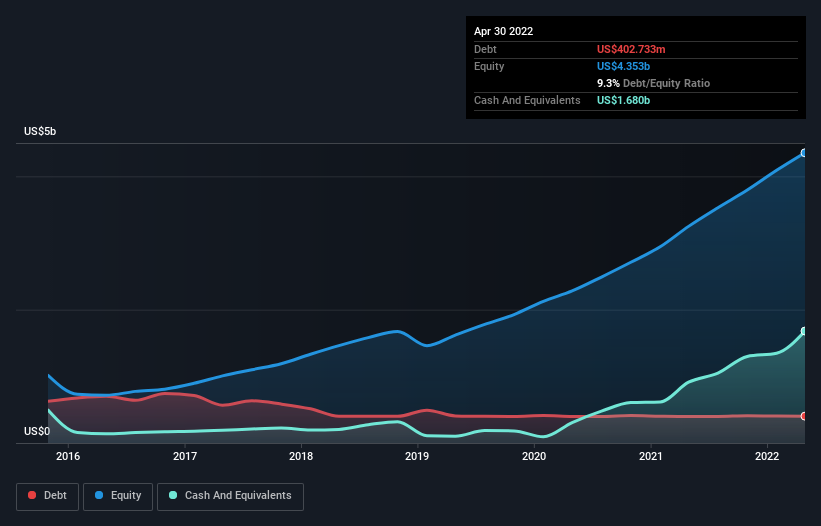These 4 Measures Indicate That Copart (NASDAQ:CPRT) Is Using Debt Safely
Some say volatility, rather than debt, is the best way to think about risk as an investor, but Warren Buffett famously said that 'Volatility is far from synonymous with risk.' So it seems the smart money knows that debt - which is usually involved in bankruptcies - is a very important factor, when you assess how risky a company is. We can see that Copart, Inc. (NASDAQ:CPRT) does use debt in its business. But should shareholders be worried about its use of debt?
When Is Debt A Problem?
Debt is a tool to help businesses grow, but if a business is incapable of paying off its lenders, then it exists at their mercy. In the worst case scenario, a company can go bankrupt if it cannot pay its creditors. However, a more common (but still painful) scenario is that it has to raise new equity capital at a low price, thus permanently diluting shareholders. Of course, debt can be an important tool in businesses, particularly capital heavy businesses. The first thing to do when considering how much debt a business uses is to look at its cash and debt together.
View our latest analysis for Copart
How Much Debt Does Copart Carry?
As you can see below, Copart had US$402.7m of debt, at April 2022, which is about the same as the year before. You can click the chart for greater detail. But on the other hand it also has US$1.68b in cash, leading to a US$1.28b net cash position.
How Strong Is Copart's Balance Sheet?
According to the last reported balance sheet, Copart had liabilities of US$449.1m due within 12 months, and liabilities of US$641.7m due beyond 12 months. Offsetting these obligations, it had cash of US$1.68b as well as receivables valued at US$135.4m due within 12 months. So it actually has US$724.3m more liquid assets than total liabilities.
This short term liquidity is a sign that Copart could probably pay off its debt with ease, as its balance sheet is far from stretched. Succinctly put, Copart boasts net cash, so it's fair to say it does not have a heavy debt load!
Also positive, Copart grew its EBIT by 30% in the last year, and that should make it easier to pay down debt, going forward. The balance sheet is clearly the area to focus on when you are analysing debt. But ultimately the future profitability of the business will decide if Copart can strengthen its balance sheet over time. So if you're focused on the future you can check out this free report showing analyst profit forecasts.
Finally, a business needs free cash flow to pay off debt; accounting profits just don't cut it. While Copart has net cash on its balance sheet, it's still worth taking a look at its ability to convert earnings before interest and tax (EBIT) to free cash flow, to help us understand how quickly it is building (or eroding) that cash balance. Looking at the most recent three years, Copart recorded free cash flow of 49% of its EBIT, which is weaker than we'd expect. That's not great, when it comes to paying down debt.
Summing Up
While we empathize with investors who find debt concerning, you should keep in mind that Copart has net cash of US$1.28b, as well as more liquid assets than liabilities. And we liked the look of last year's 30% year-on-year EBIT growth. So is Copart's debt a risk? It doesn't seem so to us. We'd be very excited to see if Copart insiders have been snapping up shares. If you are too, then click on this link right now to take a (free) peek at our list of reported insider transactions.
At the end of the day, it's often better to focus on companies that are free from net debt. You can access our special list of such companies (all with a track record of profit growth). It's free.
Have feedback on this article? Concerned about the content? Get in touch with us directly. Alternatively, email editorial-team (at) simplywallst.com.
This article by Simply Wall St is general in nature. We provide commentary based on historical data and analyst forecasts only using an unbiased methodology and our articles are not intended to be financial advice. It does not constitute a recommendation to buy or sell any stock, and does not take account of your objectives, or your financial situation. We aim to bring you long-term focused analysis driven by fundamental data. Note that our analysis may not factor in the latest price-sensitive company announcements or qualitative material. Simply Wall St has no position in any stocks mentioned.
Join A Paid User Research Session
You’ll receive a US$30 Amazon Gift card for 1 hour of your time while helping us build better investing tools for the individual investors like yourself. Sign up here

 Yahoo Finance
Yahoo Finance 
